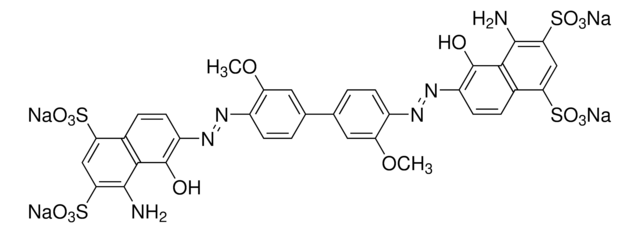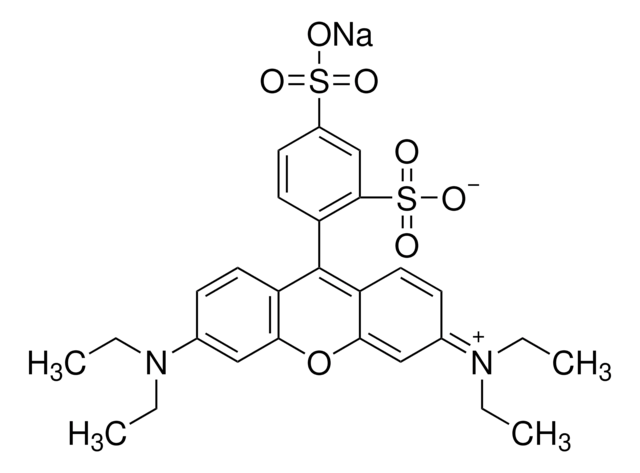302643
Trypan Blue
≥80% (HPLC), Dye content 60 %
Synonym(s):
Direct blue 14
About This Item
Recommended Products
Quality Level
assay
≥80% (HPLC)
form
powder
composition
Dye content, 60%
color
dark green to brown, or Brown-Black
mp
>300 °C (lit.)
solubility
H2O: 1 mg/mL
λmax
607 nm
ε (extinction coefficient)
≥60000 at 603-607 nm in methanol at 0.01 g/L
60000 at 603-607 nm in methanol
application(s)
diagnostic assay manufacturing
hematology
histology
storage temp.
room temp
SMILES string
[Na+].[Na+].[Na+].[Na+].Cc1cc(ccc1N=Nc2c(O)c3c(N)cc(cc3cc2S([O-])(=O)=O)S([O-])(=O)=O)-c4ccc(N=Nc5c(O)c6c(N)cc(cc6cc5S([O-])(=O)=O)S([O-])(=O)=O)c(C)c4
InChI
1S/C34H28N6O14S4.4Na/c1-15-7-17(3-5-25(15)37-39-31-27(57(49,50)51)11-19-9-21(55(43,44)45)13-23(35)29(19)33(31)41)18-4-6-26(16(2)8-18)38-40-32-28(58(52,53)54)12-20-10-22(56(46,47)48)14-24(36)30(20)34(32)42;;;;/h3-14,41-42H,35-36H2,1-2H3,(H,43,44,45)(H,46,47,48)(H,49,50,51)(H,52,53,54);;;;/q;4*+1/p-4
InChI key
GLNADSQYFUSGOU-UHFFFAOYSA-J
Gene Information
human ... PTPN1(5770) , PTPRF(5792)
Looking for similar products? Visit Product Comparison Guide
Related Categories
General description
Application
Biochem/physiol Actions
This dye is useful to differentiate the dead and live cells based on the cell′s ability to take up or exclude the dye. A viable cell is assumed to possess an intact cell membrane and hence excludes this dye and the cytoplasm appears clear. While on the other hand non-viable cells shows a blue cytoplasm.
- to determine the number of living and necrotic cells by staining with 0.2% trypan blue solution.
- to stain plant tissue in order to visualize cell death.
signalword
Danger
hcodes
Hazard Classifications
Carc. 1B
Storage Class
6.1C - Combustible acute toxic Cat.3 / toxic compounds or compounds which causing chronic effects
wgk_germany
WGK 3
ppe
Eyeshields, Gloves, type P3 (EN 143) respirator cartridges
Certificates of Analysis (COA)
Search for Certificates of Analysis (COA) by entering the products Lot/Batch Number. Lot and Batch Numbers can be found on a product’s label following the words ‘Lot’ or ‘Batch’.
Already Own This Product?
Find documentation for the products that you have recently purchased in the Document Library.
Customers Also Viewed
Our team of scientists has experience in all areas of research including Life Science, Material Science, Chemical Synthesis, Chromatography, Analytical and many others.
Contact Technical Service











